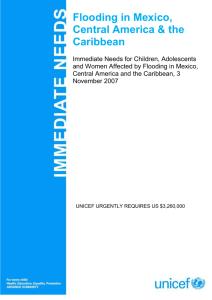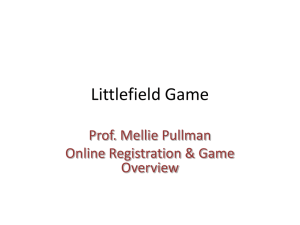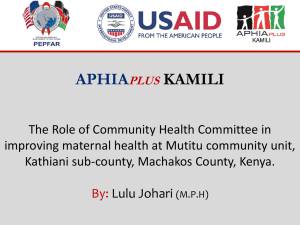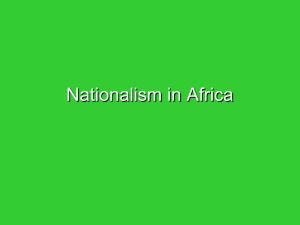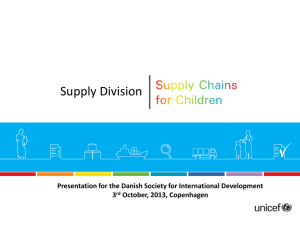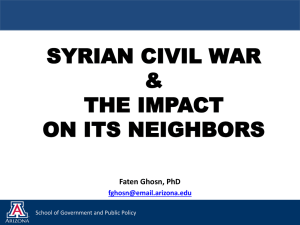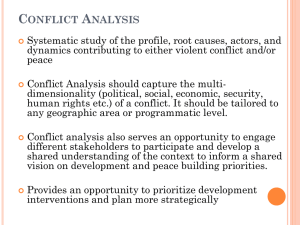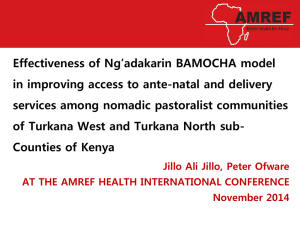Water Sanitation and Hygiene
advertisement
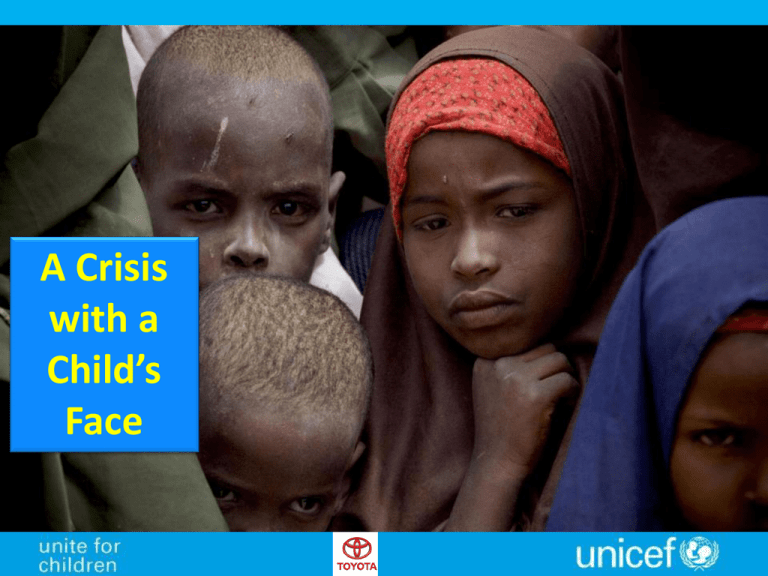
A Crisis with a Child’s Face PRESENTATION OUTLINE • A. TWO EMERGENCIES • B. WHAT IS UNICEF DOING? • • • • • Nutrition Health Water Sanitation & Hygiene Child Protection Education • C. HOW YOU CAN HELP UNICEF A. There are two emergencies in Kenya: 1. Northern Kenya : • Marginalization of communities • Repeated droughts • Pastoralists used to living with drought every 510 years, the time in between was used to rebuild livestock and food supply • Now there is a shorter drought cycle, more frequent and more intense • Climate change and environmental degradation Northern Kenya Northern Kenya (Lodwar District Hospital – Stabilization Unit) Who is most affected? • The most vulnerable in both emergencies – Children under 5 – School aged children – Children from poor households – Unaccompanied children at risk of GBV – Orphans – Pregnant and lactating mothers – The elderly Northern Kenya – People in Arid and Semi-Arid Lands in Northern (Lodwar District Kenya Hospital) A. There are two emergencies in Kenya (con’td): 2. Dadaab: • Kenya host to Somali refugees for almost 20 years in Dadaab camp and in host community • Refugees fleeing famine and insecurity in Southern Somalia • Dadaab has 3 camps – Dagahaley, Hagadera and Ifo • These camps have space for 90,000 but there are over 400,000 refugees • The Government recently opened a new camp Ifo 2 to accommodate 40,000 more refugees • Highly congested and unsanitary • About 8,000 refugees arrive every week • Most of them women and children who are acutely severely malnourished. Dadaab Dadaab Dadaab B. What is UNICEF doing? MANAGEMENT OF MALNUTRITION • Provided, 24,096 malnourished, pregnant and lactating women with supplementary feeding • With partners, scaling life-saving interventions to reach 20,000 children under 5 with severe acute malnutrition, 82,000 children under 5 with moderate acute malnutrition in Therapeutic Feeding Programmes • Continuous provision of supplies and technical support to health facilities e.g. 2,200 cartons of Ready- to-Use Foods (RUTF) airlifted from Europe reaching 2,500 severely-malnourished children Management of acute malnutrition We have a child survival crisis • Lack of food and water resulting in moderate and severely acute malnutrition • Outbreaks of diarrhoeal diseases • Cholera • Outbreaks of vaccine preventable diseases – polio and measles Screening for weight for height Mother feeding moderately malnourished child Plumpy Nut Health • Integrated immunization campaigns for measles, polio, deworming and Vitamin A, for 144,000 children • 15,000 newly-arrived refugees immunized • Procurement of 15 emergency kits (containing antibiotics, anti-inflammatory drugs and oral rehydration salts) – treating 10,000 people per month • 462 measles cases being treated in Garissa, Moyale, Mandera, Marsabit, Pokot, Samburu, Turkana and Wajir • Emergency drugs distributed to Turkana District Integrated Immunization Campaign Immunization (measles) Immunization (polio drops) Immunization (vitamin A) Water Sanitation and Hygiene • Water provided for about 22,000 refugees, by providing 1,600 jerricans and 2 water bladders (10,000 ltrs each) • Water supplies for 60,000 people (2.3 million chlorine tablets, 900,000 purification sachets, 23,000 buckets, 3,000 water filters and 31,000 bars of soap) • Agreement with NGOs to dig 5 shallow wells and to train water users’ committees in Marsabit district • Improvement of community boreholes with cattle troughs, water kiosks and distribution networks (Labisigele – near the Kenya Somali border) Filling up jerricans at water points Child Protection • Enhancing and scaling up child protection services in Dadaab refugee camp and Turkana district through existing partnerships • 700 children benefited from protective services in existing child protection centres e.g. Eldoret (children trekking from Turkana to Eldoret in search of basic social services) • Tents and 18 kits containing sports equipment and toys provided for the child-friendly spaces in Dadaab • Through the child-friendly spaces, Save the Children and UNICEF have reached 2,155 vulnerable children with psychosocial support and other services • Supply of DIGNITY KITS for girls and women Children playing in a child-friendly space In the camps children are always at risk Education • Negotiations under way to construct low cost structures in already congested school and on the outskirts occupied by newly-arrived refugees • 20 temporary learning spaces/classroom setups, 100 Education kits provided for 5,000 students, 60,000 Somali textbooks, 100 Early Childhood Development kits for 5,000 children at community level and 64 recreation kits provided to 6,400 children and young people in Dadaab • Supporting conversion of boarding schools where attendance is very low to keep girls in school • For example, in Fafi district, only 18% of children are in school of which 9% are girls Critical need for learning spaces Critical need for learning spaces How you can help UNICEF UNICEF EMERGENCY RESPONSE LIST SECTOR ITEMS NEEDED QUANTITY PURPOSE Child Protection (10) VEHICLES Nutrition (20) 4 WHEEL DRIVE Education (8) (2ND HAND) 38 • Accessing hard-to-reach areas with nutritional and health supplies and staffing (e.g. nurses.) • Coordination of educational emergency support (assessments, information flow and monitoring of supplies) • Mobility to respond to cases of gender-based violence Nutrition (20) Education (100) TENTS (Large, strong) 120 • Providing temporary learning spaces, shelter at the stabilization centres and storage space for supplies. Child Protection BUS 30-40 seater bus (2nd hand) 1 Child Protection STOVES (maendeleo portable ethanol stove) 1,500 • Transportation of children from transit centres to the camp • To be used in the refugee camps (reduction of indoor air pollution, saves firewood and is safe and portable) UNICEF EMERGENCY RESPONSE LIST SECTOR ITEMS NEEDED QUANTITY PURPOSE Child Protection SOLAR LIGHTS 250 • Illumination of latrines and walkways in the refugee camps. Health INTER-AGENCY KITS (COMPLETE KITS) 10 • Provision of health services: 1 complete kit provides drugs for care and treatment of minor illnesses for 10,000 people for 3 months. Health MALARIA RAPID DIAGNOSTIC TESTS AND ACTs (COARTEM) 5,000 each • While malaria is not presently a major threat, the possibility of rain in October and an outbreak of malaria in an already weakened population is a real threat. Health RAPID HIV/AIDS TEST KITS 10,000 • Supply of test kits for mobile clinics will ensure displaced populations can still be served through outreach clinics and transmission of HIV from mother-to-child can be avoided. Health CELLULAR BLANKETS 5,000 • Many of the facilities in northern Kenya are under-served, routine supplies and beddings are needed. UNICEF EMERGENCY RESPONSE LIST SECTOR ITEMS NEEDED QUANTITY PURPOSE Health COMPLETE MIDWIFERY KITS 36 • Support for health facility and home deliveries in 36 districts. Health COLD CHAIN EQUIPMENT, I.E. GAS FREEZERS & CORRESPONDING CYLINDER 20 • Health facilities need freezers to prepare their own ice packs to support their outreach programmes. Water, Sanitation & Hygiene MOBILE WATER TANKER 5 • Distribution of water to distant communities. Water, Sanitation & Hygiene MOBILE WATER TREATMENT SYSTEM 5 • Help vulnerable communities to purify their water resources. Water, Sanitation & Hygiene WATER TESTING KITS 10 • Ensure water safety in remote communities Water, Sanitation & Hygiene SUBMERSIBLE WATER PUMP 10 • Help communities with water shortage to pump ground water Water, Sanitation & Hygiene POWER GENERATING SET 5 • Reliable power supply is needed to ensure that water can be pumped from THANK YOU!

